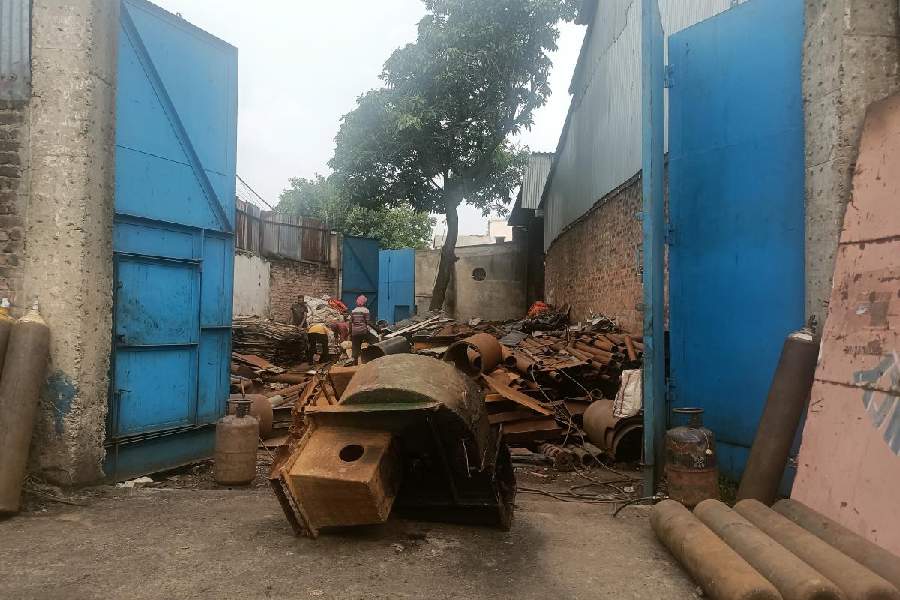I start my day listening to the tolling bells at the Hanuman temple. It is at the heart of my existence, but it is not my lifeblood. As the old joke, with my own little tweak, goes — I hate the sight of scrap, but it is in my veins. Yes, my lifeblood is scrap.
My boast is that I am Asia’s largest wholesale metal scrap market; you are free to prove me wrong. I was born about 110 years ago in Howrah and have grown since. It is a pity no one ever took time out to map my formidable expansion — up to Uluberia in the west, Maheshtala in the east and Liluah in the north. To my south flows the Hooghly.
Before I even begin to tell you what I am all about, let me clearly state what I am not. I am not acres and acres of open field with scrap dumped in it. I am a collection of small and big shops in the lanes and bylanes radiating from the Hanuman temple.
There are well over 10,000 shops and over double the number of people employed in them, and also deriving employment from them. The blanket term for most of them is “labour”, and it includes scrap peddlers, kabadiwalas, scrap retail buyers, dealers and even contractual labourers who work on the scrap.
Except for Sunday, when all goes quiet, the buzz around my station is unimaginable and equally so is the hard labour.
The scrap that comes to godowns are of several kinds. It can be anything from a four-wheeler to a large tractor, a ship to a discarded iron vessel, factory machinery to water pumps and windmills. A labourer cuts the big scrap into smaller pieces. Then these are crushed, sorted, shredded or flattened and stacked in small piles. This is a very important step because these scraps have to travel to places like Durgapur in Burdwan district for smelting.
Of late, I find women and children within my precincts, working or looking for work. I cannot say I approve. Not long ago, a supervisor type of person was refusing to let a woman enter a dump yard. He said, “This is a man’s job. The trucks bring in extremely heavy machines to the yard for cutting. Once those machines are dismantled and cut down into pieces, you can come and collect the screws, bolts and smaller pieces and keep them in a separate stack. But do not bring your niece, it is risky,” he said as the machine kept emitting what sounded like low growls — grrrr grrrr grrrr...
West Bengal is not a robust industrial belt and I have often heard people wonder where I get my scrap from. How can I be the world’s second-largest metal scrap hub? (Yes, I am that too.) What people do not understand is that I do not get waste only from Bengal.
The entire Northeast sends its scrap here. Guwahati, for example, does not have any recycling unit as of now, or so I hear. But the use of iron and aluminum water pipes in hilly areas is very high. Plastic or PVC pipes do not last in cold weather. Those worn waterpipes land up at my door.
People living in the hills also use tin shades instead of asbestos sheets for their roofs. These too make their way to me.
There are dedicated kabadiwalas in Calcutta, Howrah and the areas around, such as Salkia, Santragachhi, Alampur, Dhulagarh and so on and so forth. They go around in van rickshaws and collect household scrap. Raju kabadiwala, 85, knows how the chain works. I have heard him say, “We collect all kinds of scrap from houses and residential complexes, and sell them to the dealer. The dealer sorts and segregates them into metal, paper, plastic and glass products. Then it is sent to wholesalers and it is the wholesaler who finally brings it here.”
The other day a truck brought in scrap from Haldia. It is from the shipbreaking unit there — there is another in Kidderpore in southwest Calcutta. About 854 metric tonnes of scrap comes from cars, all of it from Panagarh in Burdwan district. Manufacturing companies auction their scrap and that, too, comes here. And a huge volume comes from the e-auction held on the MSTC website. MSTC Ltd is a central government public sector organisation under the Union ministry of steel and is involved in diversified e-commerce services.
Over the years, alongside the expansion, other elements have crept into the business.
I am the site for them, but that does not mean it has my approval. A lot of it has passed into the idiom of this place. So, for instance, when you hear labourers talk about “goonda tax”, understand that they are referring to the levy by local goons for collecting scrap from their localities.
But it is not as if all comes to naught at my address. From the womb of the furnace new things emerge, things of substantial worth in the market. The TMT bars, metal sheets and rods used for construction work are also from here. These are unbranded but with the real estate market burgeoning in Bengal, these local TMT bars are becoming popular.
Enough, I have said a lot. It is four in the afternoon and work cannot happen beyond this hour; the risks are great. The lights in the Hanuman temple come on and, as if on cue, the labourers start to take off their leather gloves, boots, metal face guards.










